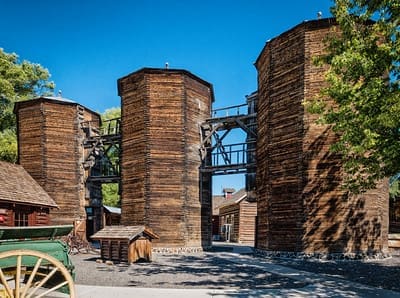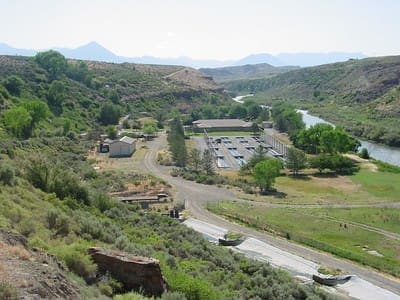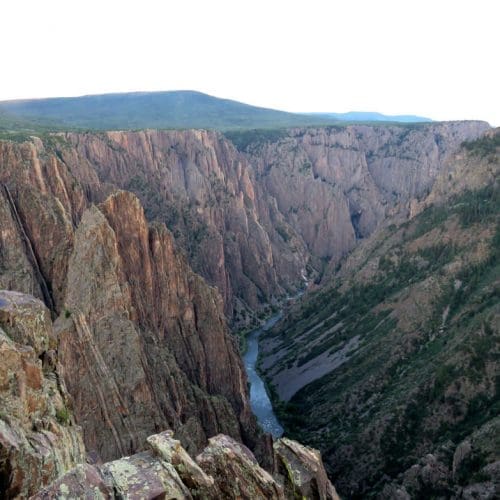Colorado is one of those rare states where, depending on which town you’re in, you might meet a rancher who’s also a hardcore mountain biker. A long history of agriculture and ranching has mixed with a tradition of outdoor adventure to create a fascinating culture in Colorado. Over the years, an influx of artists and entrepreneurs has added to the cultural tapestry, an evolution that’s especially evident in Delta County. Its six thriving towns offer excellent opportunities to experience the state’s rich Western heritage.
At the foot of Grand Mesa, the towns of Delta, Cedaredge, Orchard City, Hotchkiss, Paonia, and Crawford spread across the fertile Uncompahgre and North Fork valleys. These diverse communities are home to farmers, vintners, ranchers, and outdoor explorers, as well as artists and creative types. Each boasts its own unique flavor, but whichever one you visit, you’ll meet friendly, down-to-earth locals who are happy to show off their towns. In the quaint downtown areas, you’ll find a diverse mix of shops, art galleries, and restaurants. Numerous historic sites offer a more in-depth look at the area’s intriguing history, and festivals throughout the year bring the city streets to life.
To help you make the most of a trip to Delta County, here are a few reasons to visit each town—and what you should be sure to see, do, and eat while you’re there.
1. Delta: The City of Murals
Straddling the confluence of the Gunnison and Uncompahgre rivers, Delta began as a humble trading post on the Old Spanish Trail in 1828. Trader Antoine Robidoux swapped guns and goods with the Ute Indians, a legacy that lives on at historic Fort Uncompahgre in Confluence Park. Delta is still the commerce center of Delta County and its largest town population-wise, with a friendly downtown lined with shops, restaurants, and public art.
The town, nicknamed City of Murals, embraces the arts with colorful murals and sculptures lining Main Street. Stroll around downtown for a nostalgic look back at old Colorado, with stops at the former 1911 Delta Library, which is now the Delta County Sherriff’s Office. Delta County Historical Museum, and the classic Egyptian Theater, a National Historic Landmark built in 1928.
Delta is also a springboard to outdoor recreation. Devil’s Thumb Golf Course is a scenic spot for golf enthusiasts, but those who want to amp up the adrenaline a bit have plenty of options to choose from: Take a raft trip down the Gunnison River, go boating at Sweitzer Lake State Park, ride the famed Sidewinder Trail, or visit Dominguez Escalante National Conservation Area. Time your visit for July to celebrate the 4th of July Western Sky Balloon Festival, a lively festival with amazing array of Hot Air Balloons ascending, fireworks show, mud volley ball, craft fair, parade and more!
2. Cedaredge: Gateway to Grand Mesa

Photo Credit : Carol Jacobs-Carre
Cedaredge is the southern gateway to lofty Grand Mesa, the biggest flat-top mountain in the world. Founded in 1907, the town oozes Western hospitality. A great starting point for a visit is Pioneer Town Museum, an Old West village that recreates the area’s ranching heritage. Buildings include a schoolhouse, three wooden silos, the well-stocked Colby Store, Lizard Head Saloon, and the original jail, which dates back to 1906.
Visit Main Street in the three-block downtown to stroll among restaurants, Starr’s Guitars, and a historic brick building housing the Grand Mesa Arts and Events Center. The center brings diverse cultural experiences to Surface Creek Valley with art exhibits, classes, and concerts. Plan you visit for October and attend Applefest, one of western Colorado’s biggest events.
Cedaredge is also an excellent home base for wine lovers to explore the area’s many wineries, including Chill Switch Wines, Stoney Mesa Winery, and Williams Cellars. If you travel north of town to Grand Mesa, the land of 300 lakes, you’ll find an outdoor paradise for trout fishing, hiking, camping, and winter sports. Visit Grand Mesa Nordic Council’s website to stay update on cross county ski trials, maps, lessons, clinics races and more!
3. Orchard City: Ranches, Farms, and Orchards
Orchard City, Delta County’s largest town, covers 11 square miles along Surface Creek below the aspen-clad rim of Grand Mesa—the county’s largest town in terms of size. Three farming communities—Austin, Cory, and Eckert—banded together as Orchard City in the early 20th century to build a pipeline for fresh drinking water.
Despite its urban-sounding name, Orchard City, sitting at the crossroads of Highway 65 and North Road, is rural Colorado at its best. Stop by on your way to Grand Mesa and enjoy its vibrant agri-tourism, brimming with farms, fields, and roadside produce stands. You’ll find fresh fruit and veggies, raw honey, and, in autumn, bushels of several varieties of apples.
But it’s not just about produce here: East of town, Fruit Growers Reservoir is renowned as one of the best birdwatching spots on the Western Slope. More than 200 species inhabit the area, including sandhill cranes, nesting western grebes and willets, and American bittern. In March and April, Eckert Crane Days celebrates the return of the magnificent cranes and the arrival of spring.
4. Hotchkiss: Delta County’s Friendliest Town

Photo Credit: USFWS Mountain-Prairie
Called “the friendliest town around,” Hotchkiss is an unspoiled Colorado community with tree-lined streets, brick buildings in its historic downtown, and unobstructed views of the West Elk Range. Sitting on a bench above the North Fork of the Gunnison River, the town was named for 1881 settler and local rancher Enos Hotchkiss, who was inducted into the Cowboy Hall of Fame in 1961.
Hotchkiss is a place to stop and linger. Park the car and soak up area history at the Hotchkiss-Crawford Historical Museum and a cabin dating to the 1890s. Also be sure to visit the Creamery Art Center, a former cooperative creamery built in 1939 that now serves as an art gallery and education center. When you’ve worked up an appetite from exploring town, head to 133 Burger or Zack’s Barbeque for a bite to eat, and lively conversation with locals.
Orchards and farms dominate the open country surrounding Hotchkiss, providing organic fruit, vegetables, and grass-fed meat to restaurants across the county. The wine scene is thriving here, too: Take a drive (or hop on a bike) along quiet country roads for a tasting tour of Colorado vino at Leroux Creek Vineyards and Mesa Winds Farm and Winery. Check out West Elks Ava’s website for a full list of West Elks Wineries, events and the cannot miss West Elks Wine Trail and stop by Ela Family Farms.
At Hotchkiss National Fish Hatchery, you can see fingerling trout that are raised to stock Western Colorado lakes and streams. After the first hay cutting, the big event in Hotchkiss is the Delta County Fair in late July. The fair celebrates the county’s rich agricultural heritage, with farmers, 4-Hers, ranchers, and cowboys congregating in Hotchkiss with a downtown parade, rodeos, , and plenty of ribbons for prized livestock, pies, and homemade jams. Another noteworthy event during the spring is the Hotchkiss Sheep Camp Stock Dog Trials, with dogs and handlers herding sheep.
5. Crawford: Where the West Begins
Crawford was first settled in 1883, and visiting today is still like stepping back in time, with its unhurried pace and open spaces. The sleepy town scatters across a hillside below Youngs Peak on the western edge of the West Elk Mountains. Ranches with hayfields and grazing cattle surround the village, named for pioneer George A. Crawford, a former governor of Kansas. Get a taste of Crawford and its Old West heritage at Pioneer Days in early June. Mingle with locals at a pancake breakfast and enjoy hayrides, a baking contest, and fireworks.
The backroads around Crawford are perfect for road biking and lead to local landmarks like Needle Rock, the plug of an extinct volcano, and Crawford State Park, a beautiful spot for camping, boating, and fishing. Crawford is also the jumping-off point to explore the North Rim of the Black Canyon of the Gunnison National Park, a breathtaking natural wonder. At overlooks along the North Rim, you can peer into the sheer gorge, the deepest and narrowest canyon in North America.

Colorado’s Black Canyon is the narrowest major canyon in North America, featuring cliffs that rise 2,000 feet above the river.
6. Paonia: One of Colorado’s Coolest Towns

A savory setting at Azura Cellars looking at Lamborn Mountain.
Paonia, one of Colorado’s best undiscovered towns, sits in the morning shade of the West Elk Mountains at the head of the North Fork Valley. The quaint town is filled with farm-to-table restaurants, art galleries, B&Bs, and so many shade trees that it’s designated as Tree City USA.
Incorporated in 1902, the town gets its name from “Paeonia,” the Latin name for peony flowers (the post office requested the name to be shortened, however). The city’s center is an artistic hub known as the North Fork Creative District including artists’ studios, the Blue Sage Center for the Arts, and the historic Paradise Theatre. Wander around town and check out the vibrant art scene and diverse restaurants along downtown’s Grand Avenue.
The area is also home to an abundance of organic farms and fruit orchards, as well as eight wineries. In fact, Paonia is the epicenter of the West Elks American Viticultural Area, which includes the highest vineyards and wineries in North America. Pick a designated driver and enjoy a wine-tasting tour, and consider visiting during the West Elks AVA main events—North Fork Uncorked and West Elks Wine Trail. Stop by Big B’s legendary campground and orchard and catch a live music all summer long!If you visit in early July, you can catch Paonia Cherry Days, the town’s big event celebrating its famous cherries. Entertainment includes live music, a beer and wine garden, cherry baking contests, and even a pit-spitting contest. Another popular event is the four-day Mountain Harvest Festival in late September, which gives visitors excellent opportunities to tour area farms and wineries.
From its farms and vineyards to its trails and downtown art centers, Delta County appeals to all kinds of travelers. You can watch a rodeo, bomb downhill on a mountain bike, enjoy craft beer, and browse modern art. Over the decades, this part of Colorado has experienced a monumental evolution in Western culture, and communities have grown more diverse while honoring their traditions. Embracing the past while continuing to move forward, the towns of Delta County have created an irresistibly welcome vibe where anyone can feel welcome.
Originally written by Stewart Green for Matcha in partnership with Delta County Colorado.
Updated 12.01.2025 By Delta County Tourism

